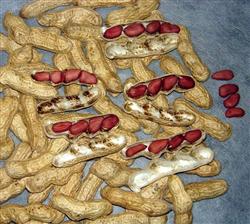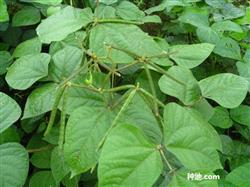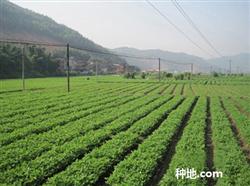How to cultivate fresh peanuts

How to cultivate fresh peanuts? Please guide that peanut is one of the main edible oil crops in the provinces south of the Yangtze River. Peanut seeds contain about 30% protein, as well as B1, B6, D and E vitamins, which play a certain role in health care, and are also known as "everlasting fruits". With the improvement of people's living standards, in addition to cooked peanuts fried or processed non-staple food, tender peanuts as fresh vegetables are in the ascendant, fresh peanuts have high planting efficiency and broad prospects for development. The high-yield cultivation techniques of fresh peanuts are as follows: 1. Soil preparation. Peanut is a deep root crop, which is suitable to be planted in sandy soil with deep 30cm, good drainage and irrigation conditions, soil organic matter not less than 0.5% and loose. In hilly areas, medium-fertility sandy soil or middle loam with a slope of less than 10 degrees should be selected for planting. Before sowing, the land was ploughed, the soil was crushed, the soil was leveled, and the furrow was made into a bed with a width of 1.2 to 1.4m and a width of 25cm. 2. Select improved varieties. Small and medium-sized fruit varieties with early maturity, good quality and concentrated fruit should be selected for fresh peanuts. The peanut varieties suitable for planting in our province are Xiaojingsheng, Dahongpao, Yuhua 10, Yuhua 15, Yuhua 9327 and so on. 3. Soaking seeds to accelerate germination. Sowing peanut seeds after sprouting is beneficial to sowing the whole seedling, preventing the lack of plants and breaking ridges, and also conducive to the cultivation of strong seedlings. The specific method is: before sowing, dry the fruit for one day and peel off the seeds. Soak the seeds in 30 ℃ warm water for 4 hours, then put them in baskets, cover with cloth and straw, keep them at a temperature of about 25 ℃ in a warm place, soak in warm water every 5 hours and keep for 24 hours to germinate. It is better to sow the seeds with only exposed radicles, and the seeds should be sowed on the same day. 4. Sowing at the right time. The suitable period for spring sowing of fresh peanuts in our province is from March 20 to April 10, and the suitable time for autumn sowing is mid-late July. The row spacing of spring sowing is 40~45cm × 30~35cm, and the planting density per mu is 4000 × 5000 clumps. The vegetative growth of peanut in autumn sowing is lower than that in spring sowing, so it should be planted closely, the row spacing is 35~40cm × 30cm, and the planting density per mu is increased to 5500-6500 clumps. Covering plastic film during spring sowing can not only advance the fresh peanut market season, but also increase the yield by about 20%. The weedy fields were sprayed with pre-budding herbicides before plastic film mulching. 50% Acetochlor 100ml was mixed with water 50kg per mu, and the border surface was sprayed evenly. After sowing, the 0.007~0.008mm microfilm was covered, and after emergence, the seedlings were punched and released. 5. Apply fertilizer scientifically. Some people think that there is no need to apply fertilizer or little fertilizer for flower root nodule growth, which limits the increase of peanut yield. According to the study, the requirement of nitrogen, phosphorus and potassium for peanut is 10:1:3. The general principles of fertilization for peanut are as follows: re-application of base fertilizer, timely topdressing and combined application of trace element fertilizer. General base fertilizer applied farm fertilizer 500kg, or ternary compound fertilizer 7.5~10kg per mu. Pay attention to the application of trace elements such as boron and molybdenum, and advocate seed dressing or basic application of molybdenum fertilizer and boron fertilizer. Before the early flowering stage (about 8 to 10 true leaves), urea 4~5kg was applied per mu to meet the fertilizer needs of fruit needles and pod development. 6. Reasonable regulation. If excessive fertilization or high temperature during the growing period led to obvious overgrowth of plants, 15% paclobutrazol 50g 60g / mu was evenly sprayed with water 50~60kg to inhibit it. 7. Pest control. Peanut taboo continuous cropping, to implement 2-3 years of rotation, the longer the number of years of rotation, the better the effect. In the later stage of peanut growth, the common disease was leaf class disease. At the initial stage of the disease, 50% carbendazim wettable powder was sprayed with 1500-2000 times liquid, once every 10-15 days, continuously for 2-4 times. Aboveground pests are mainly aphids and red spiders. 50% wettable powder 6g / mu can be sprayed with 50kg. Before sowing, soil was treated with phoxim particles, or seeds were mixed with phoxim emulsion to control nematodes. 8. Harvest at the right time. Harvest in time according to peanut maturity and market demand. Generally, the top leaves become light, the basal leaves turn yellow, and 80% of the pods are harvested when they are ripe. Click to get more peanut planting technology click to get more grain and oil crop planting technology
- Prev

How to grow autumn mung beans?
How to grow autumn mung beans? Please guide mung bean with strong adaptability, barren, drought, shade and late sowing. Autumn mung bean production should pay attention to the following techniques: 1. Select good varieties. Autumn mung bean should choose varieties with short growth period, high yield and good quality, and the ripening period should be controlled within 90 days. 2. Broadcast early at the right time. Autumn green beans can be planted until they stand.
- Next

How to fertilize peanuts scientifically?
How to fertilize peanuts scientifically? Please guide 1, the fertilization principle of peanut (1) the soil of cultivated peanut with the combination of organic fertilizer and inorganic fertilizer is mostly hill gravel soil and plain alluvial sandy soil. These soils have poor structure and low fertility. Organic fertilizers should be applied to activate the soil, improve the soil structure and fertilize the soil.
Related
- The first cup of black tea in spring, the flavor and history of tea gardens in Kenya, Africa
- The computer can not only choose potatoes, but also grow tea rice. AI will grow winter oolong tea champion.
- It is not only the inflated tea bitten by insects, but also engraved with the four seasons tea in Beipu.
- The Oriental Beauty Tea Festival in Zhuxian County takes the stage at the weekend to experience the plus-size feast of oil tea.
- & quot; Oriental Beauty Tea & Exploration of Emei in Hsinchu, the hometown of quot;
- The new variety of strawberry "Tainong 1" dessert is the first choice with mellow aroma. Crimson gorgeous
- History of Tea in Taiwan: from Wild Inner Mountain to Export Tea Garden
- Two types of Taiwan Oriental Beauty Black Tea won the British three-Star Award for Childhood Tea Xiang Zhang Jiaqi changed from pilot to champion tea maker.
- Banana species and varieties: the planting history of Taiwan Xianren banana and dwarf banana is long, is banana disease resistant?
- Coffee planting Technology: Qianjie Coffee from Seedling to harvesting

